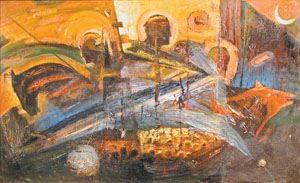Bohdan BRYNSKY: The purports of the Sixtiers are still true
An artist from Ivano-Frankivsk speaks about Opanas Zalyvakha and modern Cossacks
Sophia Kyivska has hosted an exhibit featuring the works of seven artists from Ivano-Frankivsk. The artists have toured almost all of Ukraine with the exposition. Though working in different genres and with techniques, the artists say they have a common world outlook. The Day discusses this outlook with artist Bohdan BRYNSKY.
What influence did the Ivano-Frankivsk of the late 1980s and early 1990s have on your creative work?
“In 1988 I understood that there was not enough room for me in realistic landscape painting. Then I came (in a broad meaning of the word) to Opanas Zalyvakha. He said: ‘Let’s pull you out from this.’ For six months I never held a brush in my hands, after which I produced some avant-garde works. I remember that my first work was Sich is Approaching which took part in the International Biennale Impresa’89. This was how I took shape as an artist. Today I can say it was the best time in my life. I was very excited, my paintings emerged on their own like songs, or rather like verse that is being written on its own. It was a troublesome time, albeit a very exciting one, whereas nowadays the times are not easy either, but I don’t feel the same passion.”
You have painted a series of Opanas Zalyvakha’s portraits. According to you, this artist had a great impact on your development as an artist?
“Zalyvakha was my friend, teacher and partisan. Indeed, I have painted several portraits of him. One of the pictures depicts The Day of his death and the ninth day after that. Symbolically, the canvas features fire in the foreground, and for some unknown reasons his grave lit up several weeks later.”
What purports of the Sixtiers (and Zalyvakha was a representative of this group) seem the most important today?
“Fifty years has passed since that time. I can say that my whole life, and all the purports are still alive. National questions were crucial for the Sixtiers. I wish the same was true today.”
You frequently turn to the topic of Cossacks in your creative work. Do you think the topic of Ukraine’s national liberation movement is insufficiently explored in terms of art, or are the aesthetics of Cossacks simply close to you, as an artist?
“For sure their aesthetics are close to me. Why? This is simple and complicated at the same time. I don’t remember when I started to paint Cossacks. Now I understand that this was a subconscious process. On the one hand, it is no surprise that this topic is close to me. The Brynskys are a Cossack family, with deep roots and a history dating back to ancient times. Even our looks show that we are from the steppe. As far as I understand, a Cossack is a free man from the steppe, who seeks freedom: a warrior without fear or doubts. This is what my ancestors used to be like.”
Can your Cossacks be considered as some kind of message?
“I always paint without making a sketch. When I sit down to paint, I never know what will come out of it. So, these, as you say, ‘messages’ frequently emerge on their own.”
In your opinion, is the topic of Cossacks and national liberation movement in Ukraine explored enough on a societal level?
“To my immense regret, no. These topics are scarcely explored even on a personal level, let alone the societal one. It is no secret that you should start from yourself first, because historical discussions in society are quite formal, whereas the topic of Cossackhood, in particular, includes many important vital questions, including the question of responsibility, national awareness and language.”
Your Cossacks are not bellicose. How do serious Cossacks see themselves in a post-modernist space, which views everything with skepticism?
“They are quite serious indeed, they are not caricatural, but neither are they cumbersome. They rushing on horses, seek movement, in a word, they are dynamic and modern. That’s why they are not in conflict with the modern world, it seems to me.”
You spoke about your family. It is known that your ancestor Mykhailo Brynsky was a sculptor. Can you tell us something about him, and did he influence you?
“My grandfather’s cousin lived and worked in Prague, and he acquired his artistic education in Vienna, where back in 1912 he built a monument in memory of workers who perished in 1911 in Vienna during the social upheavals. During the war, Mykhailo Brynsky created monuments dedicated to Ukrainian warriors who died in camps. However, his works include a Lenin’s sculpture, but I perceive this rather as a way to ‘bribe’ sovietdom. Mykhailo Brynsky’s works are on display at the Ivano-Frankivsk Museum of Local History. The museum’s administration was able to bring these works from Prague by some miracle. I can feel his artistic legacy, which is very strong. This refers not only to pictorial arts. I know that Mykhailo Brynsky had a beautiful voice and for five years performed in Mykhailo Starytsky’s theater. I also love singing.”
Bohdan Brynsky’s works can be seen in the Sofia Kyivska until April 10.
Newspaper output №:
№16, (2011)Section
Time Out





